Find out how people are engaging: Examples of engagement in action
Engagement in Action on GCconnex
GCconnex began with the three consultation questions—and expanded to over 120 group discussions on the Blueprint 2020 GCconnex group focused on areas of particular concern to public servants. Participants offered many positive comments and shared constructive suggestions whenever sensitive issues were raised. More than 50 other Blueprint-related groups were also created on GCconnex (for example, the Canada Revenue Agency and Public Safety Canada established department specific groups). Using GCconnex has highlighted the benefits of a social media platform employees can use to exchange ideas about the future of the Public Service.
What does the vision mean for you?
“Culture change can’t be imposed from above, nor by the institution. Culture is created and spread from the bottom up. … This is a vision of what people individually and in groups have been asking for and discussing for years.
”
– Jérôme Foldes-Busque
What is needed to make the vision a reality?
“If we innovate as individuals the system will respond, as this can be an indicator for change.
”
– Terry Kelly
Dear Wayne, we would like the following tools…
“Wikis are a great alternative to multiple versions of Word documents when composing anything with multiple authors/editors. (…)
”
– Rob McLeary
“We’d like ‘time to innovate and collaborate in unconventional ways’ to be a standard and recognized reward for good performance.
”
– Carolyn Seburn
“I agree that we ought not to believe that tools are the answer; tools are just tools. The answer comes from fully defining the problems to be solved so that we can choose -- or create -- the right tools and use them in the most effective possible way.
”
– Kevin Backs
What Does the Ideal HR System Look Like?
“What about creating groups of people that don’t work for any specific department, but where each group has skills that could be used across multiple departments. They could be “
” Human Capital Pools
” and work on a project basis, and be deployable faster, or for shorter periods (…) to meet a specific need.
– Jack Jensen
Idea widget—Open Qs and A with leaders
“I also think we should focus on creating communities of practice and maintaining the ones that are known and recognized across the Public Service.
”
– Barbara Delisle
The elephant in the room is…
“(1) information management paradigms are more suitable to a filing cabinet model and less suited to an information on demand model, (2) (…) we lack the words “how about” or “what if”, [and] (3) employees are reluctant to raise issues up.
”
– Amanda Parr
What’s BHAG (Big, Hairy, Audacious Goal) For the Public Service in 2020?
“I want the GoC to be the case studies for other countries, rathers than us always reading about them.
”
– Erin Gee
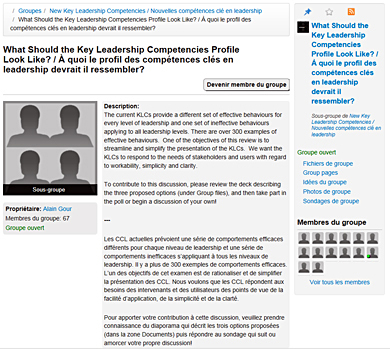
GCconnex, where virtual engagement happens!
What are the competencies required for the future of the Public Service? - Building Capabilities
“A key competency for the public service of tomorrow will be collaboration and partnership management. We will need people who specialize in bringing together the right people and who can successfully facilitate large undertakings or projects.
”
– Kim Burnett
So what should we stop doing?
“Maintaining a paper approval process keeps the PS in the mindset of developing documents for ‘print’ - when we actually print less and less every year. Our communications dependence on the web and social media will only strengthen and our organization should keep pace.
”
– Carol Anne Deneka
What can you do to help achieve the vision?
“Put the end user (employee, general public) at the centre of the design. Consider what people are actually using.
”
– GCconnex user
“Change needs to start within. Start small and grow within your org.
”
– Stephen Wynn
Improve efficiency vs red tape & risk management: are we up for it?
“To be efficient, we may have to accept some level of risk, accept that things may not be perfect, or the way we would like them… In order to do this, we may have to become better at identifying the risks, and to come up with better risk mitigation strategies.
”
– Jean-François Guay
What could the [Canada School of Public Service] do to help improve learning in the public service in the context of Blueprint 2020?
“Train and develop indeterminate employees (that express an interest) to teach courses offered by CSPS, particularly in the regions. These employees internal to government will likely use familiar terminology and relatable examples.
”
– Robyn Atkinson
Direct Stakeholder / Client Feedback: a key to innovation and high performance in the public service
“Inviting stakeholders to crowdsource program design from the ground up (including a framework for rolling feedback and improvement) would be one way of building feedback mechanisms that work…
”
– Jeremy Plaunt
Pride and Recognition
“I think it would be interesting to see something more similar to the SAVE (Securing Americans Value and Efficiency) award here in Canada’s federal public service: an award that is more targeted to collecting the best federal government wide cost-cutting ideas from public servants.
”
– Robyn Wheat
Managing Risk Aversion vs. Managing Risk
“…if our goal is to develop effective policy using collaborative teams, there has to be a significant space reserved for those working in regions on program delivery; otherwise, our advice will be less useful.
”
– Michael MacKinnon
What should be the key attributes of good Action Plans for BP2020?
“I think translating BP2020 ideas into actionable projects should be a key step for “where we go from here.” BP2020 has generated many good ideas. Some require little translation (such as e-signatures for approvals; one ID/password to access all platforms; extension of senior management committee meetings to include non-EX subject matter experts as observers), while others would require significant “translation” to achieve tangible results (e.g. delegating authority to the lowest possible level; increasing the role of communities of practice in program operations; reducing internal red tapes; opening internal communications; improving HR flexibility etc.).
”
– Erning Han
Share an Idea, Shape the Future!
“…I hope that by 2020 my entire team is an engaged community where collaboration, flexibility, durability and innovation matter…
”
– Shelly Bruce
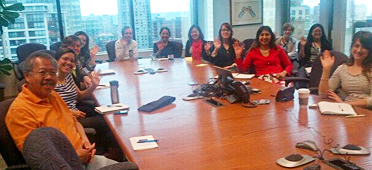
Public Works and Government Services Canada
- Pacific Region gathering for June 7th launch.
Engagement in Action in Departments and Agencies
In countless ways, deputy heads, engagement champions and employees have made this engagement process their own. The Canada School of Public Service (CSPS) provided webcast support to help departments share their Blueprint 2020 discussions with staff across the country. Aboriginal Affairs and Northern Development Canada, the Canada Border Services Agency, the Canada Revenue Agency, Environment Canada, Fisheries and Oceans Canada and the Department of Justice Canada, as well as the Federal Youth Network have all held webcasts at the School. CSPS hosted two Armchair Discussions with the Clerk of the Privy Council. These were the two largest webcast events ever held within the Public Service. The second webcast alone attracted thousands of viewers from over 60 different organizations and over 1,400 unique tweets. CSPS also hosted the Blueprint 2020 Time Capsule Ceremony, an opportunity to demonstrate public servant commitment to action in a very personal and real way.
Communications Security Establishment Canada built its Blueprint 2020 activities on MOSAiC, an ambitious engagement strategy for individual, physical and organizational transformation. One of MOSAiC’s key messages is that everyone has an opportunity to lead. Employees do not need permission to make things happen. If someone can put a good idea into action, they are encouraged to “just do it.” Western Economic Diversification Canada in turn was the first department to engage employees using the GCconnex online chat function: 68 percent of staff have signed on to GCconnex and over 50 percent have attended in-house training sessions on the use of GCconnex, GCpedia and Twitter.
“To encourage employee participation, ESDC implemented a cross-sectional, nonhierarchical, collaborative approach led by enthusiastic employees. They designed, managed and delivered a multiple channel engagement strategy using GCpedia, GCconnex, Twitter along with traditional face-to-face discussions. This multipronged approach ensured all ESDC employees had an opportunity to participate.
”
– Employment and Social Development
Canada Interim Report
Engaging employees working in a variety of small and large organizations is never the same story. For example, the Correctional Investigator Canada reached out to all its employees (36 FTEs) using staff meetings to gather broad-based and formal feedback. Meanwhile, over 21,000 Canada Revenue Agency (CRA) employees participated in Blueprint 2020 town halls, team meetings and a wide variety of events at its headquarters and in offices across the country. CRA employed a new tool called Destination 2020 which allowed over 40 percent of employees to discuss topics of interest and vote on the ideas and proposals of their colleagues. The tool proved so useful that CRA shared it with other departments and agencies to help them in their Blueprint 2020 activities.
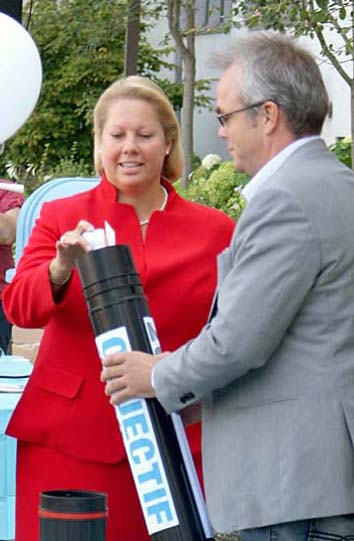
Marc Gagnon, Canada Border Services Agency,
and Diane Lafleur, ADM Lead, Blueprint 2020 Engagement
Process, at a Blueprint 2020 time capsule event held
at the Canada School of Public Service.
“At the CBSA, the creation of an open employee engagement planning group has been incredibly powerful. We started out with representatives from each region and branch of NHQ and created a forum to share ideas, brainstorm solutions and keep in touch with employee efforts across a large and geographically diverse organization. (…) widespread ownership for employee engagement has taken root.
”
– Canada Border Services Agency on GCconnex
As part of its engagement strategy, the Department of Foreign Affairs, Trade and Development held a webinar with employees at headquarters and at posts in Africa, Asia, Europe, and the Americas on Blueprint 2020. The event was also an opportunity for mission employees in places like Panama, New York, Boston, Vilnius, Stockholm, Kingston (Jamaica), Dublin, Delhi and Oslo, to participate in discussions on the future of their recently amalgamated department.
A number of organizations are building engagement efforts into ongoing renewal initiatives. The Canada Border Services Agency has integrated Blueprint 2020 as part of its Border Modernization Initiative. As well, the Blueprint 2020 activities at National Defence have aligned with the Defence Renewal engagement activities already underway given their shared focus on employee engagement.
Engagement in Action in Federal Regional Councils
Federal regional councils are uniquely positioned to show how engagement can take place across organizations. For example, the Alberta Federal Council invited public servants from a range of departments and networks to sessions in Edmonton and Calgary to share views on the vision. In addition, it held a series of social media learning events to introduce participants to Twitter, GCconnex, GCpedia, and LinkedIn. These events helped people see how these tools can play a part in connecting people to do their jobs more effectively.
The Ontario Federal Council also held a series of interdepartmental Blueprint 2020 sessions in many communities including Sault Ste. Marie, Thunder Bay and Sudbury. The Council’s Leaders without Borders graduates helped to hold events reaching out to managers and staff. These gave future leaders the opportunity to participate and share views on what is needed to make the vision a reality.
“Blueprint 2020 [is viewed] as a forerunner of a refreshing approach to public service characterized by authentic consultation, collaboration and visioning. This approach is welcomed as the foundation of an effective, efficient, engaged and responsive Public Service. The Public Service that evolves in this type of environment will maximize skills, talents, innovation and resources to provide excellent service that meets the needs and expectations of Canadians.
”
– Manitoba Federal Council Interim Report
Engagement in Action in Communities
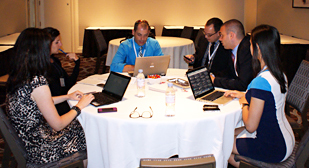
Jodi Leblanc, Veterans Affairs Canada,
Sarah Reda, Federal Youth Network,
Stéphane Tourangeau, Transport Canada,
Marc Sanderson, Canada School of Public Service,
Nick Frate, Federal Youth Network, and Erin Gee,
Canada Revenue Agency, prepare material
for the 2013 Institute of Public Administration
of Canada conference in Montreal.
Horizontal communities have actively jumped on board the Blueprint 2020 process. Two in particular have played a key role in reaching out to managers and the next generation of Public Service professionals.
The Federal Youth Network (FYN) connects young and new professionals and future leaders across the federal public service. Since the launch of the Blueprint 2020 exercise in June, FYN has mobilized thousands of public servants. It has helped promote many departmental and regional events, held networking events, and encouraged discussion on social media. It has also held an Armchair Discussion in collaboration with the Canada School of Public Service and various experts within the government.
The National Managers’ Community (NMC) connects federal public service managers from all departments and agencies across Canada to strengthen capacity, innovation and engagement. On October 3, the NMC held halfday sessions in all regions to enable dialogue on the vision and share key ideas. Managers across the country can comment and vote on ideas online using “Soapbox,
” a virtual tool available on the NMC website. Using those results, a second nation-wide event, on December 5, will come up with concrete actions and steps to help achieve the vision.
“(…) the Human Resources Council hosted an interactive and lively session (…) for Heads of HR and two invitees per department/ agency. Organizations were asked to bring participants from each of the three working generations (Baby Boomer, X and Y). This allowed us to benefit from the wisdom of those who are farther along in their careers and to capitalize on the ideas and perspective of those who will continue working in the Public Service for longer.
”
– Human Resources Council Interim Report
Engagement in Action… External Outreach
On August 20, 2013, members of the academic community and others had an opportunity to participate in a Blueprint 2020 round table as part of the 65th Annual Conference of the Institute of Public Administration of Canada. Participants commented on a range of issues, from the role of the private sector to the tools needed to support engagement and future competencies.
“Instead of reacting to the changing environment, we must learn to be steps ahead, and this can only happen if we start with a document like Blueprint 2020, embed the attitude, gain buy-in from all levels of management within the Public Service, and be innovative. To make this vision a reality, we must think like a team—the entire service as one entity (…).
”
– University of Toronto student
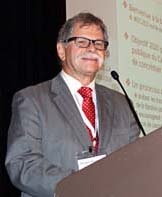
Jacques Bourgault,
Associate Professor,
Université du Québec
à Montréal
and École nationale
d’administration publique.
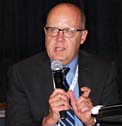
Ken Rasmussen,
Johnson Shoyama
Graduate School of
Public Policy, University
of Regina, at
the 2013 Institute
of Public Administration
of Canada conference.
A National Student Paper Competition on the Future of the Public Service was launched in fall 2013. The competition aims to bring out research presenting new knowledge and understanding that will help to turn Blueprint 2020 into reality. It is sponsored by the Canadian Association of Programs in Public Administration, the Canadian Federation of Business School Deans and universities nationwide, in collaboration with the Dalhousie University Rowe School of Business, the Johnson-Shoyama Graduate School of Public Policy University of Regina, the Canada School of Public Service and the Institute of Public Administration of Canada.
“Round table participants applauded the method of bottom-up engagement in Blueprint 2020 consultations, emphasizing that if the Public Service wishes to achieve cultural change, it will only occur with buy-in from all public servants. (…) Four key themes emerged from the discussions: improve engagement and collaboration between the Public Service and external partners; promote employee interchanges; enhance training and public service retention; and emphasize the Public Service’s enduring value.
”
– Public Policy Forum National Associations Roundtable on Blueprint 2020